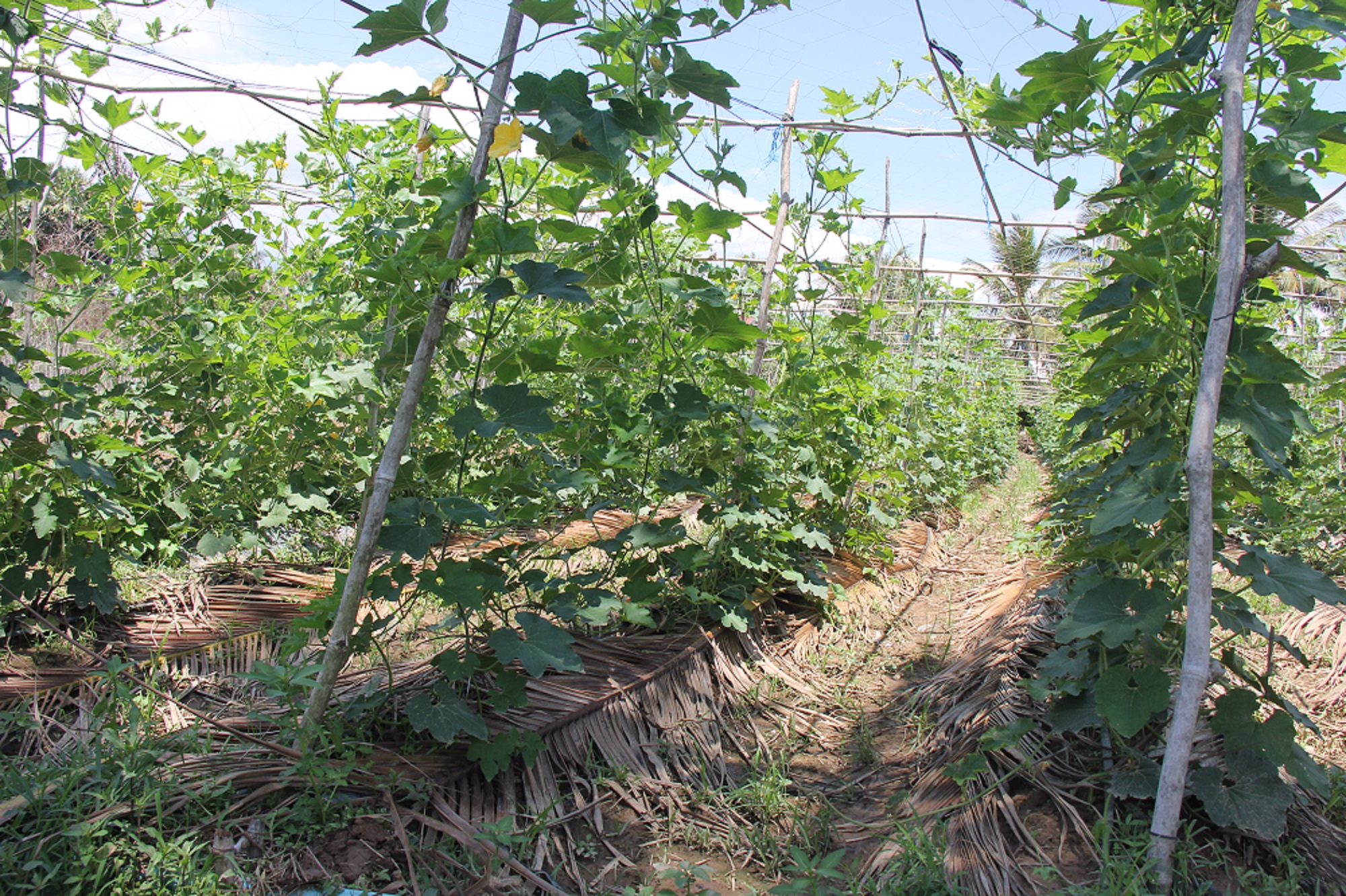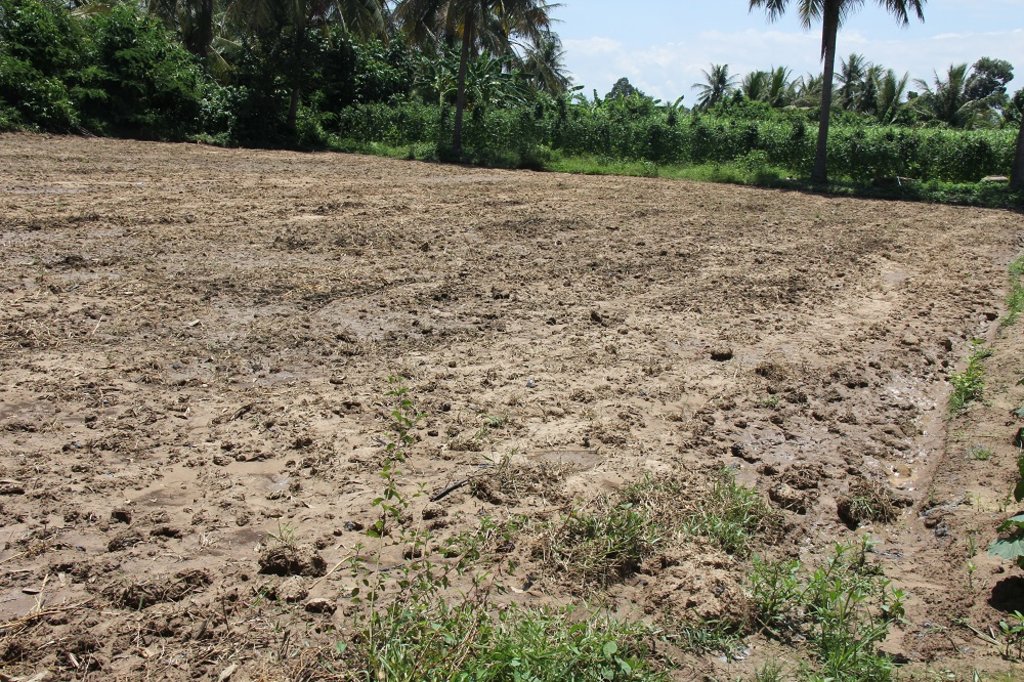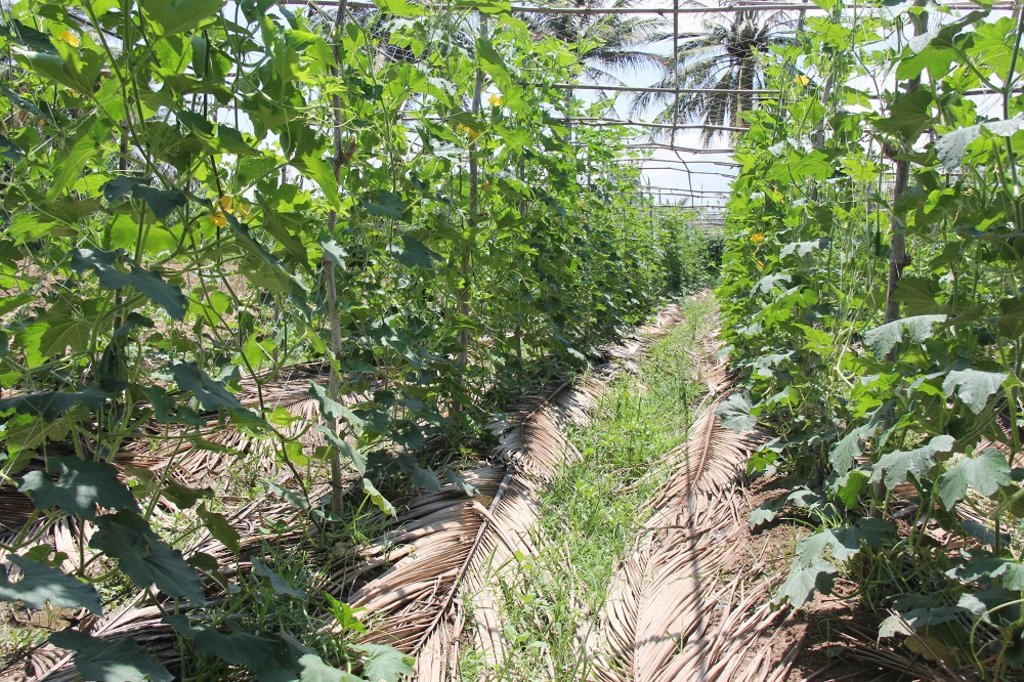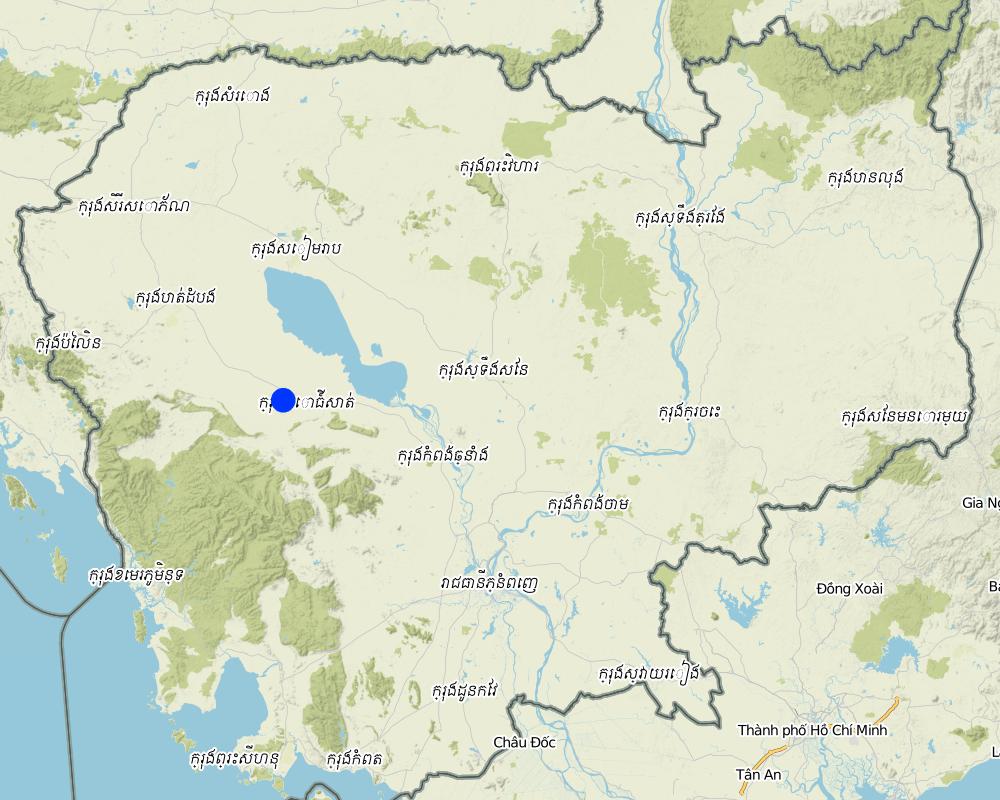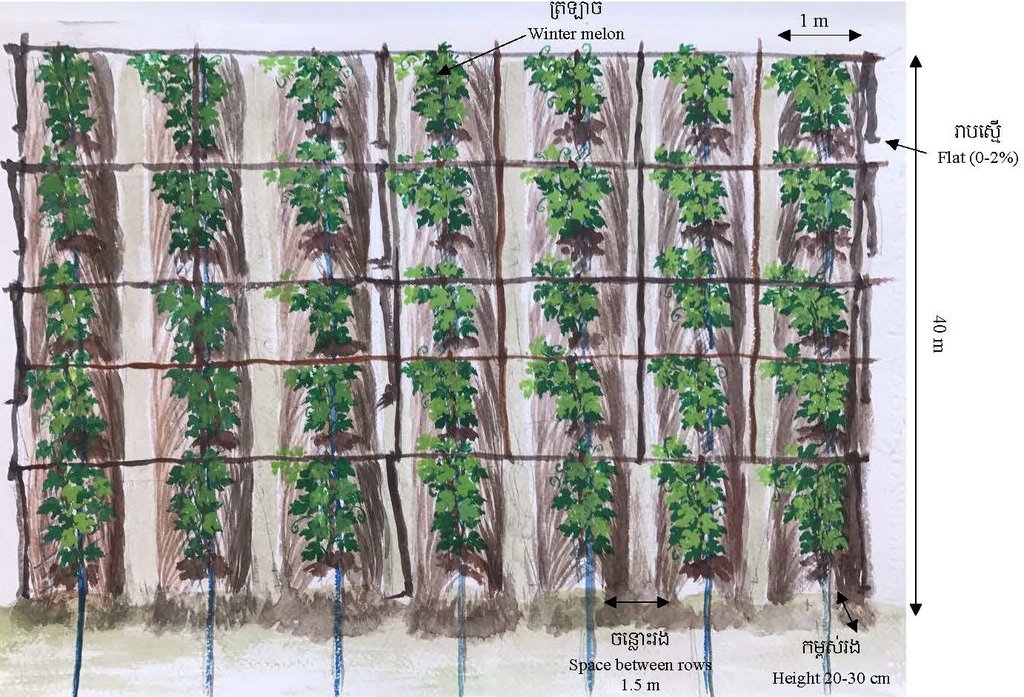ការប្រើធាងដូងជាគម្របដីសម្រាប់ផលិតកម្មដំណាំត្រឡាច [Cambodia]
- Creation:
- Update:
- Compiler: Sok Pheak
- Editors: Sophea Tim, Navin Chea
- Reviewers: Nicole Harari, SO Than, Stephanie Jaquet, Ursula Gaemperli
technologies_3152 - Cambodia
View sections
Expand all Collapse all1. General information
1.2 Contact details of resource persons and institutions involved in the assessment and documentation of the Technology
Key resource person(s)
land user:
អ៊ែល ស្រី
(+៨៥៥) ៩៧៦៥៥៥៩៧០
កសិករ
ភូមិចំការអូ ឃុំត្រពាំងជង ស្រុកបាកាន ខេត្តពោធិ៍សាត់។
Cambodia
ប្រធានការិយាល័យផ្សព្វផ្សាយកសិកម្ម:
ហ៊ន់ សុវណ្ណ
(+៨៥៥) ១៦៦៥៤៣៨៦
មន្ទីរកសិកម្ម រុក្ខាប្រមាញ់ និងនេសាទខេត្តពោធិ៍សាត់
ភូមិពាលញែក២ សង្កាត់ផ្ទះព្រៃ ក្រុងពោធិ៍សាត់ ខេត្តពោធិ៍សាត់។
Cambodia
ប្រធានការិយាល័យកសិកម្ម រុក្ខាប្រមាញ់ និងនេសាទ ស្រុកបាកាន:
វ៉ាន់ សុខុន
(+៨៥៥) ៦៨៨៣៦៥៩៨
ការិយាល័យកសិកម្ម រុក្ឋាប្រមាញ់ និងនេសាទស្រុកបាកាន
ភូមិកោះកែវ ឃុំត្រពាំងជង ស្រុកបាកាន ខេត្តពោធិសាត់។
Cambodia
មន្ត្រីក្សេត្រសាស្ត្រ:
សេង កុម្ភះ
(+៨៥៥) ៩៦៤៣៥២៦៦៥
ការិយាល័យកសិកម្ម រុក្ខាប្រមាញ់ និងនេសាទស្រុកកណ្តៀង
ភូមិកណ្តៀង ឃុំកណ្តៀង ស្រុកកណ្តៀង ខេត្តពោធិ៍សាត់។
Cambodia
Name of project which facilitated the documentation/ evaluation of the Technology (if relevant)
Scaling-up SLM practices by smallholder farmers (IFAD)Name of the institution(s) which facilitated the documentation/ evaluation of the Technology (if relevant)
Royal University of Agriculture (RUA) - Cambodia1.3 Conditions regarding the use of data documented through WOCAT
When were the data compiled (in the field)?
27/06/2017
The compiler and key resource person(s) accept the conditions regarding the use of data documented through WOCAT:
Ja
1.4 Declaration on sustainability of the described Technology
Is the Technology described here problematic with regard to land degradation, so that it cannot be declared a sustainable land management technology?
Nee
2. Description of the SLM Technology
2.1 Short description of the Technology
Definition of the Technology:
បច្ចេកទេសគម្របដីដោយប្រើធាងដូងសម្រាប់ដំណាំត្រឡាច ដើម្បីរក្សាសំណើមដី កាត់បន្ថយរំហួត បន្ថយស្មៅចង្រៃ សន្សំសំចៃទឹក ការពារការហូរច្រោះ និងបង្កើនទិន្នផលដំណាំ។
2.2 Detailed description of the Technology
Description:
ក្នុងបច្ចេកទេសនេះ កសិករយកធាងដូងស្រស់ ឬស្ងួតដាក់នៅជុំវិញរងត្រឡាចដើម្បីរក្សាសំណើមបានយូរ កាត់បន្ថយការហូតហែងដោយសារខ្យល់ និងសីតុណ្ហភាពក្តៅខ្លាំងជា ពិសេសនៅរដូវប្រាំង។ ការប្រើធាងដូងសម្រាប់ជាគម្របលើរងដំណាំត្រឡាចនេះ ក្រៅពីរក្សាសំណើមគឺនៅការពារដីពីការហូរច្រោះ ធ្វើឱ្យដីស្រូបទឹកបានល្អ បន្ថយការដុះស្មៅចង្រៃ ហើយរលួយបង្កើនជីជាតិដីទៀតផង។ ដីដែលសមស្របសម្រាប់ដំណាំត្រឡាច គឺជាប្រភេទដីល្បាប់ ល្បាយខ្យាច់ និងដីដែលនៅតាមវាលទំនាបមួយចំនួនមាន pH ចន្លោះ ៥.០ ទៅ ៦.៣។ ប្រសិនបើ pH ទាបជាង ៥.០ ការលូតលាស់របស់ ផ្លែពុំសូវល្អ និងធ្វើឱ្យដំណាំទុំមុនអាយុកាល ឬជួនកាលផ្លៃត្រឡាចស្ពោតដោយសារខ្វះសារធាតុចិញ្ចឹម (TSTD, 2012)។ ឬសរបស់ត្រឡាចមានលទ្ធភាពចាក់ចូលទៅក្នុងដីបានពី ៦៥ ទៅ ១០០ សង់ទីម៉ែត្រជា ពិសេសលើប្រភេទដីខ្យាច់។ ដំណាំប្រភេទនេះមិនត្រូវដាំនៅទីណាដែលមានខ្យល់បក់ខ្លាំងនោះទេព្រោះពេលណាសីតុណ្ហភាពឡើងខ្ពស់ហើយមានខ្យល់បក់ខ្លាំងទៀតនោះធ្វើឱ្យរុក្ខជាតិមានការបាត់បង់ជាតិ ទឹកយ៉ាងច្រើនដោយសារការដកដង្ហើមបំភាយចំហាយទឹកតាមស្លឹក។ តំបន់បែបនេះពេលខ្លះទទួលរងសីតុណ្ហភាពខ្លាំងហើយវានឹងធ្វើឱ្យត្រឡាចដុះលូតលាស់មិនល្អ។
បច្ចេកទេសគម្របដីដោយប្រើធាងដូងសម្រាប់ដំណាំត្រឡាចនេះបានអនុវត្តនៅលើផ្ទៃដីទំហំ ២៨០ ម៉ែត្រការ៉េដោយលើករងកម្ពស់ពី ២០ ទៅ ៣០ សង់ទីម៉ែត្រ ដែលរងនីមួយៗមានទទឹងប្រវែង ១ ម៉ែត្រ និង បណ្តោយមានប្រវែង ៤០ ម៉ែត្រចន្លោះពីរងមួយទៅរងមួយទៀតមានចម្ងាយ ១,៥ ម៉ែត្រ សរុបទាំងអស់មាន ៨ រង ហើយរងនីមួយៗបានដាំត្រឡាចចំនួន ៤០ គុម្ភ។ តាមគល់ដំណាំ និងតាមចន្លោះរងដំណាំត្រូវ បានក្រាលដោយធាងដូងហើយក្រាលសណ្តូកតាមរងដំណាំ ការក្រាលនេះមិនក្រាស់ មិនស្តើងពេក គឺប្រមាណជា ៥ ទៅ ៦ធាងសង្ខាងគល់ដំណាំ។ ដើម្បីចំចេញពេលវេលា និងសន្សំសំចៃទឹក កសិករបាន ជ្រើសរើសប្រព័ន្ធដំណក់ទឹកសម្រាប់ធ្វើការស្រោចស្រពដោយប្រើទុយោដំណក់ទឹកដែលមានអាត្រាដំណក់ទឹក ៦ លីត្រក្នុងមួយម៉ោងមួយគុម្ភ ហើយស្រោចស្រពចំនួន ២ ដងក្នុង មួយថ្ងៃ (ព្រឹក ល្ងាច) ហើយម្តង រយៈពេល២០នាទីក្នុង ១ នាទីបន្តក់ទឹកបាន១០០ មីលីលីត្រ (រដូវវស្សាការស្រោចស្រពត្រូវបានបន្ថយតាមការជាក់ស្តែង)។ ចំពោះដំណាំត្រឡាចការស្រោចទឹកគឺមិនត្រូវឱ្យដក់ទឹកនោះទេ ហើយក៏មិនត្រូវ ស្រោចទឹកនៅពេលថ្ងៃត្រង់ ឬនៅពេលល្ងាចដែរពីព្រោះវាអាចធ្វើឱ្យមានបញ្ហាដូចជា រលួយឬសងាប់ដើមត្រឡាច។ បើពិនិត្យឃើញដីនៅក្បែរគល់ស្ងួត ត្រូវស្រោចទឹកបន្ថែមភ្លាមៗដោយមិនត្រូវទុកដីឱ្យស្ងួតទេ។ ជាពិសេសបន្ទាប់ពីដាំកូនហើយពីព្រោះកូនដំណាំត្រូវការទឹក និងជីសម្រាប់ការដុះលូតលាស់ ឬស ដើម ស្លឹក និងផ្លែផ្កា។ កំឡុងពេលដំណាក់កាលចេញផ្កា និងផ្លែនៃវគ្គលូតលាស់របស់ដំណាំត្រឡាច ត្រូវពិនិត្យតាមដានទឹកឱ្យបានទៀងទាត់។ ដោយសារដីនេះពីមុនមកជាដីដាំអំពៅមិនសូវមានជីជាតិ ហេតុនេះកសិករបានដាក់បន្ថែមនូវជីសរីរាង្គ (លាមកគោ) និងជីគីមីបន្តិចបន្តួចដែរ។ បន្ថែមពីនេះថ្នាំកំចាត់សត្វល្អិតក៏បានប្រើប្រាស់ក្នុងបរិមាណមួយសមស្រប។
ជារួមតម្រូវការក្នុងការអនុវត្តបច្ចេកទេសនេះ គឺបានប្រើប្រាស់សម្ភារដែលមានតម្លៃថោក ហើយងាយស្រួលរកបាននៅមូលដ្ឋាន ដូចជាធាងដូងជាដើម តែក៏មានការទិញសម្ភារបន្ថែមពីផ្សារទៀតដែរ ដូចជា ទុយោ ខ្សែខ្មៅ ។ល។ តែទោះជាយ៉ាងនេះក្តី បច្ចេកទេសនេះក្រៅពីការបង្កើនគុណភាពដី និងរក្សាបរិស្ថានគឺបានផ្តល់នូវផលចំណេញជាក់ស្តែងដល់កសិករចំនួន ៨០០,០០០ រៀល (២០០ដុល្លារអាមេរិច) ក្នុង ១ រដូវកាល។
2.3 Photos of the Technology
2.5 Country/ region/ locations where the Technology has been applied and which are covered by this assessment
Country:
Cambodia
Region/ State/ Province:
ភូមិចំការអូ ឃុំត្រពាំងជង ស្រុកបាកាន ខេត្តពោធិ៍សាត់
Map
×2.6 Date of implementation
Indicate year of implementation:
2013
2.7 Introduction of the Technology
Specify how the Technology was introduced:
- through projects/ external interventions
Comments (type of project, etc.):
គម្រោងហាវែសឧបត្ថម្ភដោយ USAID និងគម្រោងជម្រុញផលិតកម្មផ្នែកបន្លែ
3. Classification of the SLM Technology
3.1 Main purpose(s) of the Technology
- improve production
- adapt to climate change/ extremes and its impacts
- create beneficial economic impact
3.2 Current land use type(s) where the Technology is applied

Cropland
- Annual cropping
Main crops (cash and food crops):
ដំណាំត្រឡាច
If land use has changed due to the implementation of the Technology, indicate land use before implementation of the Technology:
ដីពីមុនបានដាំអំពៅចាប់ពី១៩៩២ ដល់ ២០១២។
3.3 Further information about land use
Water supply for the land on which the Technology is applied:
- full irrigation
Number of growing seasons per year:
- 3
Specify:
រយៈពេលប្រមូលផលចាប់ពី ២ ទៅ ២ខែកន្លះ/ឆ្នាំ
3.4 SLM group to which the Technology belongs
- improved ground/ vegetation cover
- ground water management
3.5 Spread of the Technology
Specify the spread of the Technology:
- evenly spread over an area
3.6 SLM measures comprising the Technology

agronomic measures
- A2: Organic matter/ soil fertility
3.7 Main types of land degradation addressed by the Technology

soil erosion by water
- Wt: loss of topsoil/ surface erosion

chemical soil deterioration
- Cn: fertility decline and reduced organic matter content (not caused by erosion)

biological degradation
- Bl: loss of soil life

water degradation
- Ha: aridification
3.8 Prevention, reduction, or restoration of land degradation
Specify the goal of the Technology with regard to land degradation:
- prevent land degradation
4. Technical specifications, implementation activities, inputs, and costs
4.1 Technical drawing of the Technology
4.2 Technical specifications/ explanations of technical drawing
បច្ចេកទេសនេះត្រូវបានអនុវត្តនៅលើផ្ទៃដីទំហំ ២៨០ ម៉ែត្រការ៉េ។ នៅក្នុងការដាំត្រឡាចទទឹងរងមានប្រវែង ១ ម៉ែត្រ និងបណ្តោយរង ៤០ ម៉ែត្រ។ កសិករបានទុកចន្លោះរងប្រវែង ១,៥ ម៉ែត្រ សរុបមាន ៨ រង។ សណ្ឋានដីមានលក្ខណៈរាបស្មើ (០-២%) និងជាប្រភេទដីល្បាប់ និងល្បាយខ្សាច់។ សកម្មភាពបង្កើតរួមមាន ការរៀបចំគ្រាប់ពូជ ការតម្លើងប្រព័ន្ធស្រោចស្រព ធ្វើជើងជម្រដើមត្រឡាច និងស្ទួងគ្រាប់ត្រឡាច ការដាំដុះគ្រាប់ត្រឡាចដោយប្រើគម្របស្លឹកដូង។ កសិករប្រើប្រាស់លាមកគោ ផេះអង្កាម និងស្រកីដូងជាប្រភពសរីរាង្គ និងធ្វើឱ្យប្រសើរឡើងសារធាតុសរីរាង្គក្នុងដីសម្រាប់ការពារលំនឹងបរិស្ថាន។
4.3 General information regarding the calculation of inputs and costs
Specify how costs and inputs were calculated:
- per Technology area
Indicate size and area unit:
២៨០ ម៉ែត្រ
If using a local area unit, indicate conversion factor to one hectare:
១០០០០ ម៉ែត្រការ៉េ
other/ national currency (specify):
រៀល
Indicate exchange rate from USD to local currency (if relevant): 1 USD =:
4000.0
Indicate average wage cost of hired labour per day:
២៥០០០ ៛
4.4 Establishment activities
| Activity | Type of measure | Timing | |
|---|---|---|---|
| 1. | ភ្ជួរដីហាលទុកចោល | Agronomic | បន្ទាប់ពីប្រមូលផលរួច |
| 2. | ពូនរងដំណាំ | Agronomic | មុនពេលចាប់ផ្តើមភ្លៀង |
| 3. | តម្លើងប្រព័ន្ធស្រោចស្រព | Management | មុនពេលដាំកូនត្រឡាច |
| 4. | ចោះរណ្តៅសម្រាប់ស្ទួងគ្រាប់ត្រឡាច | Agronomic | ២ ថ្ងៃមុនពេលស្ទួងកូនត្រឡាច |
| 5. | ដាំគ្រាប់ត្រឡាចដោយប្រើធាងដូង | Agronomic | ១ ថ្ងៃ |
| 6. | ធ្វើទ្រើង | Structural | ៣ ថ្ងៃបន្ទាប់ពីស្ទូងរួច |
| 7. | ស្ទួងកូនត្រឡាច | Agronomic | មុនពេលចាប់ផ្តើមភ្លៀង |
4.5 Costs and inputs needed for establishment
| Specify input | Unit | Quantity | Costs per Unit | Total costs per input | % of costs borne by land users | |
|---|---|---|---|---|---|---|
| Labour | រៀបចំកូនដំណាំ | ថ្ងៃ | 1.0 | 25000.0 | 25000.0 | 100.0 |
| Labour | រៀបចំដីដាំ | ថ្ងៃ | 5.0 | 30000.0 | 150000.0 | 100.0 |
| Labour | ធ្វើទ្រើង | ថ្ងៃ | 2.0 | 25000.0 | 50000.0 | 100.0 |
| Labour | តម្លើងប្រព័ន្ធស្រោចស្រព | ដុំ | 2.5 | 27500.0 | 68750.0 | 100.0 |
| Equipment | ចបកាប់ | គ្រឿង | 2.0 | 7000.0 | 14000.0 | 100.0 |
| Equipment | កន្ត្រៃកាត់ | គ្រឿង | 5.0 | 2500.0 | 12500.0 | 100.0 |
| Equipment | រណាអារ | គ្រឿង | 1.0 | 12000.0 | 12000.0 | 100.0 |
| Equipment | ពូថៅ | គ្រឿង | 1.0 | 12000.0 | 12000.0 | 100.0 |
| Equipment | ធុងស្រោចទឹក | គូ | 2.0 | 25000.0 | 50000.0 | 100.0 |
| Equipment | ចបជីក | គ្រឿង | 3.0 | 15000.0 | 45000.0 | 100.0 |
| Fertilizers and biocides | ថ្នាំសម្លាប់សត្វល្អិត | ដប | 2.0 | 2500.0 | 5000.0 | 100.0 |
| Fertilizers and biocides | ដេ អា ប៉េ (DAP) | ដប | 2.0 | 25000.0 | 50000.0 | 100.0 |
| Fertilizers and biocides | កាលី | គ.ក | 50.0 | 2400.0 | 120000.0 | 100.0 |
| Fertilizers and biocides | អ៊ុយរ៉េ | គ.ក | 50.0 | 1800.0 | 90000.0 | 100.0 |
| Fertilizers and biocides | លាមកគោ | ថ្ងៃ | 1.0 | 25000.0 | 25000.0 | 100.0 |
| Construction material | ខ្សែខ្មៅសម្រាប់ធ្វើទ្រើង | គ.ក | 5.0 | 47000.0 | 235000.0 | 100.0 |
| Construction material | ទុយោទឹក | ដុំ | 2.5 | 90000.0 | 225000.0 | 100.0 |
| Construction material | ក្បាលរ៉ូប៊ីណេ | ចំនួន | 1.0 | 20000.0 | 20000.0 | 100.0 |
| Other | ពូនរង | ថ្ងៃ | 2.0 | 25000.0 | 50000.0 | 100.0 |
| Total costs for establishment of the Technology | 1259250.0 | |||||
4.6 Maintenance/ recurrent activities
| Activity | Type of measure | Timing/ frequency | |
|---|---|---|---|
| 1. | ស្រោចទឹកនៅពេលព្រឹក និងពេលល្ងាច | Management | ១ថ្ងៃ ២ ដង ហើយ១ដង ២ ទៅ ៣ នាទី រៀងរាល់ថ្ងៃ។ |
| 2. | កាត់ស្មៅ ឬកាត់ខ្នែង (៣ ទៅ ៤ ខ្មែង) | Management | រៀងរាល់១៤ថ្ងៃម្តងកំឡុងពេលលូតលាស់ |
| 3. | បាញ់ថ្នាំដង្កូវបើមាន | Management | នៅពេលមាន |
| 4. | ជុសជុលប្រព័ន្ធស្រោចស្រព | Management | ជុសជុលម្តងក្នុង១រដូវកាល |
| 5. | ផ្លាស់ប្តូរខ្សែខ្មៅសម្រាប់ធ្វើទ្រើង | Structural | ជុសជុលម្តងក្នុង១រដូវកាល |
4.7 Costs and inputs needed for maintenance/ recurrent activities (per year)
| Specify input | Unit | Quantity | Costs per Unit | Total costs per input | % of costs borne by land users | |
|---|---|---|---|---|---|---|
| Labour | កាត់ខ្នែងត្រឡាច | ថ្ងៃ | 1.0 | 25000.0 | 25000.0 | 100.0 |
| Labour | ជុលជុលប្រព័ន្ធស្រោចស្រព | ថ្ងៃ | 1.0 | 20000.0 | 20000.0 | 100.0 |
| Equipment | ទិញទុយោប្រព័ន្ធស្រោចស្រព | គ.ក | 8.0 | 4700.0 | 37600.0 | 100.0 |
| Equipment | ផ្លាស់ប្តូរខ្សែខ្មៅសម្រាប់ធ្វើទ្រើង | គ.ក | 7.0 | 4700.0 | 32900.0 | 100.0 |
| Total costs for maintenance of the Technology | 115500.0 | |||||
4.8 Most important factors affecting the costs
Describe the most determinate factors affecting the costs:
ជុសជុលទុយោទឹកតម្លៃ ២០០០០០ រៀលក្នុង ១ ដង និងទិញខ្សែខ្មៅសម្រាប់ធ្វើទ្រើងដំណាំតម្លៃ ៣៧៦០០ រៀលក្នុង ១ ដង។
5. Natural and human environment
5.1 Climate
Annual rainfall
- < 250 mm
- 251-500 mm
- 501-750 mm
- 751-1,000 mm
- 1,001-1,500 mm
- 1,501-2,000 mm
- 2,001-3,000 mm
- 3,001-4,000 mm
- > 4,000 mm
Specifications/ comments on rainfall:
នៅ ២០១៥ កម្ពស់ទឹកភ្លៀងប្រចាំឆ្នាំ ១២២៥.៧
នៅ ២០១៤ កម្ពស់ទឹកភ្លៀងប្រចាំឆ្នាំ ១១២៨.១
នៅ ២០១៣ កម្ពស់ទឹកភ្លៀងប្រចាំឆ្នាំ ១៣១៦
Indicate the name of the reference meteorological station considered:
ក្រសួងធនធានទឹក និងឧតុនិយម (២០១៥)
Agro-climatic zone
- sub-humid
5.2 Topography
Slopes on average:
- flat (0-2%)
- gentle (3-5%)
- moderate (6-10%)
- rolling (11-15%)
- hilly (16-30%)
- steep (31-60%)
- very steep (>60%)
Landforms:
- plateau/plains
- ridges
- mountain slopes
- hill slopes
- footslopes
- valley floors
Altitudinal zone:
- 0-100 m a.s.l.
- 101-500 m a.s.l.
- 501-1,000 m a.s.l.
- 1,001-1,500 m a.s.l.
- 1,501-2,000 m a.s.l.
- 2,001-2,500 m a.s.l.
- 2,501-3,000 m a.s.l.
- 3,001-4,000 m a.s.l.
- > 4,000 m a.s.l.
Indicate if the Technology is specifically applied in:
- not relevant
5.3 Soils
Soil depth on average:
- very shallow (0-20 cm)
- shallow (21-50 cm)
- moderately deep (51-80 cm)
- deep (81-120 cm)
- very deep (> 120 cm)
Soil texture (topsoil):
- fine/ heavy (clay)
Soil texture (> 20 cm below surface):
- medium (loamy, silty)
Topsoil organic matter:
- high (>3%)
5.4 Water availability and quality
Ground water table:
< 5 m
Availability of surface water:
good
Water quality (untreated):
for agricultural use only (irrigation)
Is water salinity a problem?
Nee
Is flooding of the area occurring?
Nee
5.5 Biodiversity
Species diversity:
- medium
Habitat diversity:
- medium
5.6 Characteristics of land users applying the Technology
Sedentary or nomadic:
- Sedentary
Market orientation of production system:
- commercial/ market
Off-farm income:
- 10-50% of all income
Relative level of wealth:
- average
Individuals or groups:
- individual/ household
Level of mechanization:
- mechanized/ motorized
Gender:
- women
Age of land users:
- middle-aged
5.7 Average area of land owned or leased by land users applying the Technology
- < 0.5 ha
- 0.5-1 ha
- 1-2 ha
- 2-5 ha
- 5-15 ha
- 15-50 ha
- 50-100 ha
- 100-500 ha
- 500-1,000 ha
- 1,000-10,000 ha
- > 10,000 ha
Is this considered small-, medium- or large-scale (referring to local context)?
- small-scale
5.8 Land ownership, land use rights, and water use rights
Land ownership:
- individual, titled
Land use rights:
- individual
Water use rights:
- communal (organized)
- individual
5.9 Access to services and infrastructure
health:
- poor
- moderate
- good
education:
- poor
- moderate
- good
technical assistance:
- poor
- moderate
- good
employment (e.g. off-farm):
- poor
- moderate
- good
markets:
- poor
- moderate
- good
energy:
- poor
- moderate
- good
roads and transport:
- poor
- moderate
- good
drinking water and sanitation:
- poor
- moderate
- good
financial services:
- poor
- moderate
- good
6. Impacts and concluding statements
6.1 On-site impacts the Technology has shown
Socio-economic impacts
Production
crop production
Comments/ specify:
ការប្រើគម្របធាងដូងសម្រាប់គ្រប់លើដំណាំធ្វើឱ្យដីរក្សាសំណើមបានល្អ បង្កើនជីជាតិធ្វើឱ្យដំណាំលូតលាស់ល្អ និងទទួលបានទិន្នផលច្រើន។
Income and costs
expenses on agricultural inputs
Comments/ specify:
កសិករបានប្រើប្រាស់វត្ថុធាតុដើមក្នុងស្រុក (ធាងដូង) ដែលអាចរកបាននៅជុំវិញផ្ទះដោយមិនមានការចំណាយ។
farm income
Comments/ specify:
តាមរយៈការអនុវត្តបច្ចេកទេសនេះ (ការធ្វើឱ្យដី និងសំណើមដីកាន់តែប្រសើរឡើង) ផលិតកម្មដំណាំកើនឡើងច្រើន និងផ្តល់សារៈសំខាន់ក្នុងការរកចំណូលបន្ថែមបានផងដែរ។
Socio-cultural impacts
food security/ self-sufficiency
Comments/ specify:
បន្ទាប់ពីកសិករបានអនុវត្តបច្ចេកទេសនេះគាត់បានបន្លែសម្រាប់ផ្គត់ផ្គង់នៅក្នុងផ្ទះរបស់គាត់គ្រប់គ្រាន់ ហើយអាចលក់ចេញដើម្បីបានប្រាក់ចំណូលបន្ថែម។
health situation
Comments/ specify:
ការដាំដំណាំត្រឡាចដោយមិនប្រើប្រាស់សារធាតុគីមី។ គាត់បានបរិភោគបន្លែដែលមានសុខភាពល្អ។
SLM/ land degradation knowledge
Comments/ specify:
កសិករបានមានចំណេះដឹងពីរបៀបរក្សាដីឱ្យមានសំណើមដែលជួយការពារសំណឹកដី និងបន្កើនផលិតភាពដំណាំតាមរយៈការអនុវត្តបច្ចេកទេសគ្រប់គ្រងដីប្រកបដោយចីរភាពដែលពីមុនដីរបស់គាត់ពីមុនមិនអាចដាំដុះបន្លែបាន។ គាត់ខិតខំកែប្រែដីពីគ្មានជីជាតិទៅជាដីដែលមានជីជាតិដោយប្រើប្រាស់លាមកសត្វ (គោ) លាយជាមួយដីស្រទាប់លើ។
Ecological impacts
Water cycle/ runoff
evaporation
Comments/ specify:
រំហូតបានធ្លាក់ចុះនៅកន្លែងដែលបានអនុវត្តបច្ចេកទេសតាមរយៈការប្រើប្រាស់ធាងដូងដែលវាបានជួយរក្សាសំណើមដីកំឡុងពេលរដូវក្តៅ។
Soil
soil moisture
Comments/ specify:
ដីមានសំណើមបើទោះបីជាស្ងួតរយៈពេល ៣ថ្ងៃ។
soil organic matter/ below ground C
Comments/ specify:
ការកែប្រែដីពីខ្សោះជីជាតិទៅជាដីដែលមានជីជាតិដោយប្រើលាមកគោលាយជាមួយស្រទាប់ដីខាងលើទើបធ្វើឱ្យសារធាតុសរីរាង្គក្នុងដីកើនឡើង។
Climate and disaster risk reduction
drought impacts
Comments/ specify:
ដោយសារតែដីមានសំណើម រុក្ខជាតិត្រឡាចអាចរស់បានទោះបីជាគ្រោះរាំងស្ងួតកើតមានឡើងក្នុងរយៈពេលត្រឹម ១ សប្តាហ៍។
6.3 Exposure and sensitivity of the Technology to gradual climate change and climate-related extremes/ disasters (as perceived by land users)
Gradual climate change
Gradual climate change
| Season | Type of climatic change/ extreme | How does the Technology cope with it? | |
|---|---|---|---|
| annual temperature | increase | moderately | |
| seasonal temperature | summer | increase | moderately |
| annual rainfall | increase | moderately |
Climate-related extremes (disasters)
Meteorological disasters
| How does the Technology cope with it? | |
|---|---|
| local rainstorm | moderately |
Hydrological disasters
| How does the Technology cope with it? | |
|---|---|
| flash flood | moderately |
6.4 Cost-benefit analysis
How do the benefits compare with the establishment costs (from land users’ perspective)?
Short-term returns:
positive
Long-term returns:
positive
How do the benefits compare with the maintenance/ recurrent costs (from land users' perspective)?
Short-term returns:
positive
Long-term returns:
positive
6.5 Adoption of the Technology
- 10-50%
If available, quantify (no. of households and/ or area covered):
មាន ១៦ គ្រួសារនៅក្នុងភូមិចំការអូបានអនុវត្តបច្ចេកទេសនេះ (រួមបញ្ចូលអ្នកបានអនុវត្តបច្ចេកទេសនេះ)
Of all those who have adopted the Technology, how many have did so spontaneously, i.e. without receiving any material incentives/ payments?
- 10-50%
Comments:
មាន ៨ គ្រួសារដែលបានទទួលយកការអនុវត្តបច្ចេកទេសនេះដោយមិនបានទទួលសម្ភារ/ការឧបត្ថម្ភជាទឹកប្រាក់នោះទេ។ ទោះបីជាយ៉ាងណាក៏ដោយ មានគ្រួសារផ្សេងៗទៀតដែលបានទទួលការគាំទ្រពី គម្រោងហាវែសឧបត្ថម្ភដោយ USAID រួមមានបច្ចេកទេសដាំដំណាំ និងការប្រើប្រាស់ជី។ រីឯគម្រោងជម្រុញផលិតកម្មផ្នែកបន្លែបានផ្តល់វគ្គបណ្តុះបណ្តាលស្តីពីសុវត្តិភាពស្បៀងសម្រាប់តម្រូវការទីផ្សារ។
6.6 Adaptation
Has the Technology been modified recently to adapt to changing conditions?
Nee
6.7 Strengths/ advantages/ opportunities of the Technology
| Strengths/ advantages/ opportunities in the land user’s view |
|---|
| ការប្រើធាងដូងសម្រាប់គ្របគល់ដំណាំត្រឡាចនេះមានលក្ខណៈល្អប្រសើរសម្រាប់កសិករដែលមិនមានប្រាក់ទិញថង់ផ្លាស្ទីក។ |
| វាបានផ្តល់លក្ខខណ្ឌល្អប្រសើរដល់សុខភាពដី និងថែរក្សាស្ថេរភាពបរិស្ថាន។ |
| Strengths/ advantages/ opportunities in the compiler’s or other key resource person’s view |
|---|
| វាពិតជាមានសារៈសំខាន់ណាស់ដែលកសិករយល់ដឹងពីបរិស្ថាន ហើយពូកគេអាចស្វែងរកសម្ភារៈទាំងអស់នៅជុំវិញផ្ទះរបស់ពួកគេដូចជាធាងដូងជាដើម ដែលមិនបានបំពុលដល់បរិស្ថាន។ |
| ថែរក្សាគុណភាពដីតាមរយៈការប្រើប្រាស់ជីលាមកគោ។ |
6.8 Weaknesses/ disadvantages/ risks of the Technology and ways of overcoming them
| Weaknesses/ disadvantages/ risks in the land user’s view | How can they be overcome? |
|---|---|
| ពិបាកធ្វើលើកដំបូងដោយសារដីពិបាក់ដាំដុះ។ | ព្យាយាមធ្វើបន្តដោយកែប្រគុណភាពដី។ |
7. References and links
7.1 Methods/ sources of information
- field visits, field surveys
ចំនួន ១ នាក់
- interviews with land users
ចំនួន ២ នាក់
- interviews with SLM specialists/ experts
ចំនួន ៣ នាក់
7.2 References to available publications
Title, author, year, ISBN:
Lalljee, B., 2013. Mulching as a mitigation agricultural technology against land degradation in the wake of climate change. International Soil and Water Conservation Research, 1(3), pp. 68-74.
Available from where? Costs?
អាចទាញយកបាន
7.3 Links to relevant information which is available online
Title/ description:
Agricultural Technique Manual of Tonle Sap Poverty Reduction and Smallholder Development Project
URL:
http://www.tssdcambodia.org/
Links and modules
Expand all Collapse allLinks
No links
Modules
No modules


